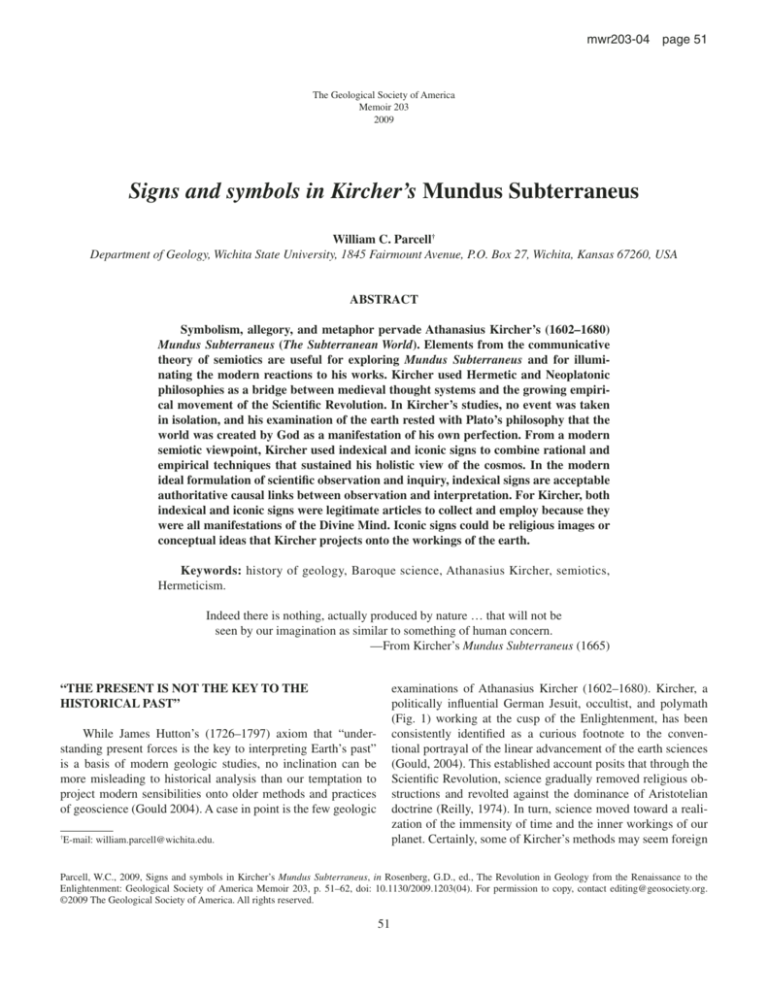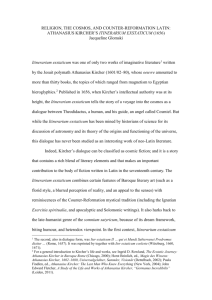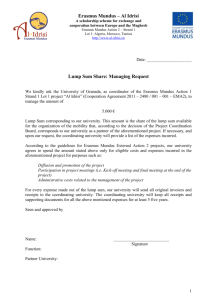
mwr203-04
page 51
The Geological Society of America
Memoir 203
2009
Signs and symbols in Kircher’s Mundus Subterraneus
William C. Parcell†
Department of Geology, Wichita State University, 1845 Fairmount Avenue, P.O. Box 27, Wichita, Kansas 67260, USA
ABSTRACT
Symbolism, allegory, and metaphor pervade Athanasius Kircher’s (1602–1680)
Mundus Subterraneus (The Subterranean World). Elements from the communicative
theory of semiotics are useful for exploring Mundus Subterraneus and for illuminating the modern reactions to his works. Kircher used Hermetic and Neoplatonic
philosophies as a bridge between medieval thought systems and the growing empirical movement of the Scientific Revolution. In Kircher’s studies, no event was taken
in isolation, and his examination of the earth rested with Plato’s philosophy that the
world was created by God as a manifestation of his own perfection. From a modern
semiotic viewpoint, Kircher used indexical and iconic signs to combine rational and
empirical techniques that sustained his holistic view of the cosmos. In the modern
ideal formulation of scientific observation and inquiry, indexical signs are acceptable
authoritative causal links between observation and interpretation. For Kircher, both
indexical and iconic signs were legitimate articles to collect and employ because they
were all manifestations of the Divine Mind. Iconic signs could be religious images or
conceptual ideas that Kircher projects onto the workings of the earth.
Keywords: history of geology, Baroque science, Athanasius Kircher, semiotics,
Hermeticism.
Indeed there is nothing, actually produced by nature … that will not be
seen by our imagination as similar to something of human concern.
—From Kircher’s Mundus Subterraneus (1665)
“THE PRESENT IS NOT THE KEY TO THE
HISTORICAL PAST”
examinations of Athanasius Kircher (1602–1680). Kircher, a
politically influential German Jesuit, occultist, and polymath
(Fig. 1) working at the cusp of the Enlightenment, has been
consistently identified as a curious footnote to the conventional portrayal of the linear advancement of the earth sciences
(Gould, 2004). This established account posits that through the
Scientific Revolution, science gradually removed religious obstructions and revolted against the dominance of Aristotelian
doctrine (Reilly, 1974). In turn, science moved toward a realization of the immensity of time and the inner workings of our
planet. Certainly, some of Kircher’s methods may seem foreign
While James Hutton’s (1726–1797) axiom that “understanding present forces is the key to interpreting Earth’s past”
is a basis of modern geologic studies, no inclination can be
more misleading to historical analysis than our temptation to
project modern sensibilities onto older methods and practices
of geoscience (Gould 2004). A case in point is the few geologic
†
E-mail: william.parcell@wichita.edu.
Parcell, W.C., 2009, Signs and symbols in Kircher’s Mundus Subterraneus, in Rosenberg, G.D., ed., The Revolution in Geology from the Renaissance to the
Enlightenment: Geological Society of America Memoir 203, p. 51–62, doi: 10.1130/2009.1203(04). For permission to copy, contact editing@geosociety.org.
©2009 The Geological Society of America. All rights reserved.
51
mwr203-04
52
page 52
Parcell
himself into the crater of Mount Vesuvius for closer observation
immediately before its eruption in 1638 (Fig. 2).
This paper examines the cultural influences on Kircher and
his use of symbolism in Mundus Subterraneus to communicate
his ideas and observations about the earth. Modern explanative
theories such as semiotics, the study of signs and their meaning,
suggest that an understanding of cultural environment, historical
context, and external influences is essential to begin to extract
original meaning from an historical text or analysis. This paper
will demonstrate that elements from semiotics are quite useful
to interpret Kircher’s discussions of the earth. We begin with a
discussion of the historical context and philosophical influences
on Kircher and continue with application of semiotics to Mundus
Subterraneus (1664, 1665).
ATHANASIUS KIRCHER AND MUNDUS
SUBTERRANEUS: TWO ANOMALOUS ENTITIES
Figure 1. Portrait of Athanasius Kircher (1602–1680) by Cornelius
Bloemart (1603–1680) from the 1664 edition of Mundus Subterraneus.
to modern readers, and some of his conclusions are flatly incorrect. However, conventional accounts of the progression
of earth science rarely take into account contributions of men
such as Kircher. Beyond his inclusion in historical surveys of
the earth sciences, there have only been a few investigations of
Kircher’s geological work (see Baldwin, 1993; Leinkauf, 1993;
Nummedal, 2001; Waddell, 2006) and even fewer from a geologist’s perspective (see Gould, 2004).
Kircher’s investigations of the earth in his immense twovolume tome, Mundus Subterraneus (1664–1665) are replete with
an astounding and strange variety of subjects, including astrology,
volcanoes, alchemy, mining, dragons, weather, eclipses, fossils,
and gravity (Godwin 1978). Peculiar to the ears and eyes of modern practitioners of geology, Kircher often calls upon religious and
hermetic philosophies in his interpretations of the subterranean
world. Yet, he also presents experimental observations throughout
his treatise, and, like Pliny before him, he saw the need to lower
Athanasius Kircher’s life spanned most of the seventeenth
century, and, as such, his career bridged a changing society.
Early in his career, the polymath’s tendencies toward generalization and integrated studies were accepted, even praised, in the
learned community (Findlen, 2004). Kircher was a respected, if
controversial, contemporary of Johannes Kepler, Robert Boyle,
and Isaac Newton, all of which maintained an interest in Hermeticism, Neoplatonism, and alchemy. Scientific research during Kircher’s early career still incorporated mystical thought
and philosophy. As Godwin (1978, p. 5) states, the purpose of
examinations of the universe at that time “was nothing less than
to penetrate the workings of the Divine Mind.” However, by the
latter half of the 1600s, Kircher’s intellectual authority began to
decline as his academic peers turned toward specialization as the
preferred path to knowledge (Findlen, 2004). This period also saw
the shift from religious-based interpretations to observational and
empirical interpretations. While philosophical divisions appeared
between objective examinations of the physical world and subjective interpretations of mind and thought, Kircher maintained
his holistic worldview of an integrated physical and spiritual universe. Throughout his discussions of the earth, Kircher uses sign,
symbol, analogy, allegory, and even dream-states as mechanisms
for conveying his interpretations of the world. These permitted
him to maintain the philosophical association between the physical and spiritual world.
The Mundus Subterraneus (Fig. 3) was arguably the most
popular of Kircher’s works in his day. By the time of its printing
in 1664 and 1665, Kircher had become famous among learned
men across Europe and even the New World. With a career that
would eventually include over 40 books under his name, by
the time of Mundus, Kircher was a publishing machine, and
his influence reached both the common man and the growing
academic community. References to his works are found in the
writings and correspondence by many of the great contemporary scientists, including Martin Lister (1639–1712), Robert
Moray (1608?–1673), Baruch Spinoza (1632–1677), John
mwr203-04
Signs and symbols in Kircher’s Mundus Subterraneus
page 53
53
Figure 2. Engraving of the eruption of Mount Vesuvius in 1638. From Mundus Subterraneus
(2nd edition, 1678).
Locke (1632–1704), Henry Oldenburg (1618–1677), Nicolas
Steno (1638–1686), Christian Huygens (1629–1695), Gottfried
Leibnitz (1646–1716), Robert Boyle (1627–1691), and Rene
Descartes (1596–1650).
As with Kircher, the Mundus Subterraneus has been a problematic work for historians to fit into the traditional description
of the evolution of the earth sciences. Godwin (1978) describes
the work as “a textbook in general science…[which] does not
broach new frontiers of knowledge but proffers its information
in a readable and lavishly illustrated form, free from mathematical and philosophical complexities.” (Godwin, 1978, p. 84).
Oldroyd (1996) considered the work to be a reflection of “what
the seventeenth-century man in the street may have thought of
the Earth’s interior.” According to Oldroyd, it “gave expression
to the beliefs of his day, and in his illustrations he reveals what
many sixteenth- and seventeenth-century writers thought was
going on in the Earth’s interior.” (Oldroyd, 1996, p. 36). However, most of Mundus Subterraneus has never been translated
into English (Fig. 4) from its original Latin (1665, 1678) editions or Dutch (1682) versions. The majority of analyses of the
work from an English perspective have therefore focused on
the “lavish” illustrations and have not tackled the accompanying 800+ pages of text. The text and accompanying images are
actually extremely complex in their philosophical, experimental,
and theological treatment of the earth.
The Mundus Subterraneus represents a philosophical bridge
between medieval thought systems and the growing empirical
movement, which we today, in retrospect, regard as the Scientific
Revolution. Kircher used a sophisticated combination of theological and empirical techniques that sustained his holistic view
of the earth. It is interesting and significant to note that Kircher’s
works related to the earth proved controversial to his contemporaries on both sides of the growing theological-secular divide. Of
all his published works, the only volume disapproved of by Jesuit
censors on philosophical grounds was the precursor to Mundus
and his first geological manuscript, Iter Exstaticum II (1657)
(Fig. 5). Some of his other works did face Jesuit scrutiny, but it
was focused on the quality and style in Ars magna sciendi (1631)
and factual inaccuracies in Iter Hetruscum (1661) (Siebert, 2004).
The Iter Exstaticum II was itself an expansion of an earlier work,
Itinerarium exstaticum (1655), which discussed the cosmology
of the universe above Earth and presented the discussion in a fictional dream-state, possibly as a means to get past Jesuit censors
(Rowland, 2004). The subsequent Iter Exstaticum II added discussion of the structure and workings of Earth. These additions
proved problematic for one particular Jesuit censor, who argued
mwr203-04
54
page 54
Parcell
Figure 3. The frontispiece of Mundus Subterraneous (2nd edition,
1678) illustrates the influences of hermetic and Roman Catholic principles on Earth. At the top of the image, God’s hand sustains Earth
through the influence of the Trinity (the winged sphere penetrated
by the serpent). The serpent holds a banner with the quotation from
Virgil’s Aeneid that reads, “The Spirit supports from within infused
through its every member, Mind sets mass in motion and mingles itself
with the mighty body.” Earth hangs between the opposing hermetic
principles of the Sun and Moon (see text for explanation). Earth is
also surrounded by the twelve winds (an allusion to the influence of
the twelve signs of the Zodiac). At the base of the illustration, two figures represent man’s attempts to measure and understand the terrestrial
world (on the left) and heavens (on the right).
that Kircher was boastful and disobedient, incorrectly explaining
the motion of the seas and using various philosophical arguments
that contradicted Aristotle’s authoritative view of the natural
world (Siebert, 2004). Kircher opposed the teaching of Holy Writ
in the book of Ecclesiastes by denying that springs and rivers
originate in the sea. Instead, Kircher asserts that springs and rivers are produced only by the condensation of air into vapor.
Figure 4. Title page from the partial English translation (“The Vulcanos…” 1669) of portions of Mundus Subterraneus. This English text
only includes parts of Kircher’s work dealing with volcanoes. The title
page also refers to the recent fire of London of 1666 and was probably
a means to draw interest in the work.
Kircher’s secular contemporaries also took issue with
Mundus. For example, Steno did not agree with Kircher’s position that mountain chains can be categorized based on geographic
orientation. While Kircher distinguishes a series of east to west
chains crossed by a very high north to south belt, Steno recognized three types of mountains based on mechanical processes
(Adams, 1938).
HERMETIC INFLUENCES ON
KIRCHER’S “GEOCOSM”
Of the many influences on Kircher, two are of particular significance to his geologic analyses: Roman Catholicism and Hermeticism. While it is assumed that the modern reader understands
the essentials of Catholic doctrine, the same cannot be assumed
of Hermeticism, and so it should be described in brief.
mwr203-04
Signs and symbols in Kircher’s Mundus Subterraneus
page 55
55
Corpus Hermeticum is a set of 16 books set up as dialogues between Hermes and a series of personages.
A related Hermetic work, The Emerald Tablet of Hermes
Trismegistus, is a short tract that includes the well-known dictum “As above, so below.” This statement of correspondence
became the mantra for a holistic philosophy that could be, at
least in part, accommodated within a Christian worldview. The
so-called Tablet became a foundation of medieval and Renaissance alchemy. Commentaries and/or translations were published by, among others, Roger Bacon, Michael Maier, Albertus
Magnus, and Isaac Newton.
Ficino and the other Renaissance scholars who studied the
Hermetic texts accepted the ancient historical provenance claimed
within the Hermetica. Encouraged by Church authorities, these
scholars believed that Hermetic philosophy was an ancient forerunner, possibly Egyptian in origin, and prophetic of Christianity. The influence of these works should not be underestimated
(Yates, 1966). Copernicus, when introducing the heliocentric
hypothesis, quotes the words of Hermes Trismegistus from the
Asclepius when he states:
Figure 5. Title page from Iter Extaticum II (1657), a work that proved
problematic to Jesuit censors on the basis that Kircher’s interpretation of Earth contradicted Aristotle’s authoritative view of the natural
world. This work became the prelude for Mundus Subterraneus.
Historical surveys of the earth sciences have often mentioned the influence of Neoplatonism and alchemy in Kircher’s
geological and paleontological work, but references to Hermetic philosophy are usually made only to degrade, demean, or
dismiss a particular conclusion or method. These are unfortunate and unconstructive assertions. By employing Hermeticism,
Kircher attempted to understand the earth using “naturalistic”
explanations while maintaining a holistic religious system of
correspondences.
A powerful philosophical force in the Renaissance, Hermeticism and its related philosophies of alchemy and Neoplatonism,
have today become a symbol of medieval and superstitious practices. Hermeticism is a set of philosophical and religious beliefs
based upon writings attributed to Hermes Trismegistus, a fusion
of the classical Greek god Hermes and the ancient Egyptian god
Thoth. While elements of Hermetic doctrine were known in the
Middle Ages through the work entitled Asclepius, Hermeticism
was broadly reintroduced to the West in 1460 CE, when a monk
named Leonardo di Pistoia brought the Corpus Hermeticum to
Pistoia, Italy. Subsequently translated by Marsilio Ficino, the
For, the sun is not inappropriately called by some people the lantern of
the universe, its mind by others, and its ruler by still others. [Hermes]
the Thrice Greatest labels it a visible god, and Sophocles’ Electra, the
all-seeing. Thus indeed, as though seated on a royal throne, the sun
governs the family of planets revolving around it. Moreover, the earth
is not deprived of the moon’s attendance. On the contrary, as Aristotle
says in a work on animal, the moon has the closest kinship with the
earth. Meanwhile the earth has intercourse with the sun, and is impregnated for its yearly parturition.
—From Copernicus (1543, Chapter 10)
Giordano Bruno (1548–1600), in defense of his ideas of the
movement of Earth, adapted the view discussed in the Corpus
Hermeticum that Earth is not immobile because it is alive
(Yates, 1966):
Hermes: After all, what is the energy of life? Is it not movement? What,
then in the cosmos is unmoving? Nothing, my son.
Tat: Does the earth seem to you unmoving, father?
Hermes: No, my son. It is the only thing full of movement, and at
the same time stationary. Would it not be absurd for the nourisher of
all things, the producer of and begetter of all, to be motionless? It is
impossible for one who brings forth to do so without movement. It
is most absurd to ask whether the fourth element earth is idle, for an
unmoving body signifies nothing but idleness.
Then know, my son, that without exception everything in the cosmos
this is, is moving, whether decreasing or increasing, and that which
moves is alive.
—Translation from Salaman et al. (2000, p. 63)
Even James Hutton, in the last part of the eighteenth century,
wrote his doctoral dissertation on the circulation of blood in the
microcosm, reflecting the persistent Hermetic principle that man,
the microcosm, reproduces in miniature, or is directly influenced
by, events of the macrocosm (Eisely, 1960).
However, by the early seventeenth century, Hermeticism
had begun to lose its widespread appeal. Subsequent analysis of
mwr203-04
56
page 56
Parcell
Hermetic texts claimed that the extant Hermetic writings were
not the work of an ancient Egyptian priest but were in fact dated
to the early Christian era (Quispel, 2000). After this reevaluation,
the Corpus Hermeticum began to fall out of favor.
Kircher, working in the waning years of the Hermetic revival, borrowed ideas from alchemic and Neoplatonic philosophies when emphasizing his holistic approach. In Kircher’s
studies, no event is taken in isolation. Behind Kircher’s examination of Earth rests Plato’s philosophy that the universe or great
world order was fashioned by God the creator as a manifestation and illustration of his own perfection: “and so he formed it
as a single visible living thing which was to include all related
creatures … by turning it he shaped it into a sphere …, giving
it the most perfect form of all” (from Plato’s Timaeus in Roob,
2006, p. 35). In sacred geometry, the sphere is the ultimate expression of unity, completeness, and integrity. In the sphere,
there is no reference point given greater or lesser importance,
and all points on the surface are equally accessible and regarded
by the center from which all originate. From the second chapter
of Mundus, Leinkauf (1993) recognized that in order to maintain the Church’s doctrine of the geocentric position of Earth
and the finiteness of the universe, Kircher cleverly describes the
subterranean world as an analog for the greater universe itself,
where God is the nondimensional center (or punctum) of the
cosmic reality, and Earth represents the absolute perfect and
finite geometric structure (the sphere). By manipulating the ambiguity of the word mundus, Kircher could refer to either Earth
as an isolated planetary body, or the whole cosmos (Rowland,
2004). Kircher also uses the terms “geocosm” and “geocosmos”
in this bimodal fashion.
In studies of alchemic practices of the Jesuits in the seventeenth century, Baldwin (1993) acknowledged the influence of
alchemy on Kircher’s interpretation of Earth. She states that
Kircher maintained that the geocosm was the prototype for
alchemical processes and that careful observation of geological
events could teach alchemists the perfection of their art. From a
geologic perspective, it can also be argued that throughout the
Mundus, Kircher used descriptions of alchemic laboratories and
processes (which he actively practiced) as analogs for an interpretation of the earth. In this way, his techniques can be seen as a precursor to the use of modern analogs for interpretation of ancient
earth processes. Instead of “the present is the key to Earth’s past,”
Kircher’s interpretive maxim could be, “the modern laboratory
is the key to Earth’s past.” The various alchemic techniques of
heating, evaporating, calcining, coagulating, hardening, and fixating could be used as conceptual models for understanding the
formation of Earth. He had ascended Vesuvius in 1638 and had
himself lowered inside its crater. Escaping the wrath of Vesuvius,
a few days later he witnessed the volcanic eruption from fifty
miles away. His observations were interpreted within his circle of
influence. He likened the volcano’s heat to that of the alchemist’s
furnace, its smoke to that of his alchemical concoctions, and its
stench to the sulfur and bitumen fumes, which he inhaled in his
laboratory (Baldwin, 1993).
Kircher’s comparison of the workings of Earth to an alchemic
project largely focuses on the opposing principles of fire and
water. Astrologically, the Sun and the Moon represent these elements and signify two opposing principles. The Sun represents
fire, sophic sulfur, God, the King, Spirit, and ultimately the One
Mind of the universe. The Moon represents water, sophic salt,
the Queen, the Holy Ghost, Soul, and ultimately the One Thing
of the universe. It is indeed interesting to note that the Sun and
Moon are the only two heavenly bodies described in detail other
than Earth in Mundus Subterraneous. In fact, individual chapters
are devoted to these objects.
At the microcosmic scale, the alchemic principles of fire
and water were used as a philosophical foundation for understanding eruptions of volcanoes. From observations along the
Apennine Peninsula, Kircher notes that the oceans tend to recede and then rise in relation to ensuing volcanic eruptions.
He draws an association between the two events and explains
their correspondence through the important Hermetic principle
of maintaining equilibrium between fire (volcanoes) and water
(the ocean). Kircher describes the oceans filling in subterranean
voids left behind by escaping fires that feed volcanoes and,
hence, extinguishing the eruptions.
Equilibrium of fire and water is also used at a macrocosmic
scale. Through the conjunction of these two primordial elements,
Earth becomes the perfect spherical eunuch (Fig. 6). Citing elements from alchemy, sacred geometry, and Catholic theology,
Kircher’s spherical geocosm is described in terms of a living castrated being. As a spherical eunuch, Earth becomes a metaphor
for perfect neutrality and the neutral stage in all reality for mankind to exist (Leinkauf, 1993).
SIGNS IN MUNDUS SUBTERRANEUS
Semiotics is the study of signs and how meaning arises by
the heuristic process of perceiving and conceiving objects. This
explanative theory is useful for exploring Kircher’s interpretations and is also useful for illuminating the modern reactions to
his works. We can approach Mundus with semiotics by examining how Kircher recognized and interpreted various natural signs.
In the most elementary terms, signs can be defined as something
present that represents something absent (Leeds-Hurwitz, 1993).
In semiotics, a sign is a set of characteristics that represents an
object to somebody in some capacity. Characteristics of an object
govern what sign or signs are recognized. In turn, a sign creates
in the mind of a person an equivalent or more developed sign or
idea, the interpretant (Chandler, 2007).
Two conceptual models dominate the modern study of semiotics. Figure 7A illustrates the Saussurean dyadic sign model,
termed “signification.” The Swiss linguist Ferdinand de Saussure
(1857–1913) organized the formulation of meaning as a relationship between a “signifier” and a “signified concept.” The “signifier” is commonly interpreted as the physical form of a sign,
that is, something which can be perceived by our senses. The
“signified” is the mental conception of the meaning of the sign.
mwr203-04
Signs and symbols in Kircher’s Mundus Subterraneus
page 57
57
Figure 6. Kircher’s interpretation of
the interweaving of fire and water in the
subterranean world. This was a reflecspherical eunuch.
Figure 7. The two principal sign system models found in modern semiotics. The upper diagram (A) illustrates the Saussurean dyadic sign
model, termed “signification.” Here, the sign system is a formulation
of meaning as a relationship between a “signifier” and a “signified
concept.” The “signifier” is the form that the sign takes and is something perceived by our senses. The “signified” is the mental conception
of the meaning of the sign. The lower diagram (B) demonstrates the
Peircean triadic sign system model. This model posits three elements:
an object, a representamen, and an interpretant. An object is an item
identified by an understood common, shared characterization or classification. The representamen is a characteristic that signifies something
in a particular capacity. The interpretant is the conception or implication of the sign.
mwr203-04
58
page 58
Parcell
Figure 7B demonstrates the Peircean triadic sign system model.
The American philosopher Charles Peirce (1839–1914) distinguished three elements within his derivation of a sign model:
an object, an representamen, and an interpretant. The “object”
is what a sign stands for (or represents). The sign itself (or “representamen”) is what is perceived by our senses. The “interpretant” is the mental conception of the sign. The interpretant then
becomes itself a sign in the mind of the interpreter.
A sign system may be perceived and conceived in three aspects: (1) symbolically, (2) indexically, or (3) iconically. A symbolic
sign is one that does not bear a resemblance to its object and therefore its relationship must be learnt. Examples of symbolic signs
include languages, letters, numbers, and map symbols. Conversely,
an indexical sign is physically or causally connected to the object.
Examples of indexical signs include medical symptoms, natural
events, measuring instruments, and video or audio recordings. An
indexical association can be observed or inferred. An iconic sign
is perceived as resembling or imitating the object being similar
in possessing some of its qualities. Iconic signs include portraits,
scale-models, metaphors, and imitative gestures (Chandler, 2007).
As discussed already, Kircher’s method of understanding
Earth was founded on upholding a coherent, logical system while
sustaining the Hermetic macrocosm-microcosm tradition, which
maintains Christian theology and the philosophy that supported
it. These two principles profoundly influenced Kircher’s perception of signs and the meaning attributed to them.
In the earth sciences, Kircher is remembered in a large part
for misidentifying fossils and their origins (Fig. 8). Kircher’s
examination of figured stones were formed through sign recognition (textures, familiar images, etc.) that was influenced by
the Christian and Hermetic traditions. In some cases, Kircher
recognized the figures as actual remains of organisms. In
other cases, the images were perceived to simply “look” like
organisms. (Gould [2004] suggested that these probably were,
in fact, molds of fossils.) Some of the stone figures were even
identified as representing religious images. What is important
to note is that in each of these cases, Kircher’s interpretations
of stones were directly related to whether he perceived their
characteristics as indexical or iconic of the object. Kircher’s
recognition of religious imagery and figured stones “resembling” fossils are classic example of iconic signs. The stones
resemble religious figures or possess some of the qualities of
petrified organisms but are not the actual object of reference.
Since Kircher saw the sign itself as simply imitating the object
and not the object itself, he showed little concern for how these
signs actually appear on stones. For him, the ultimate purpose
of understanding the natural world was to understand the Divine
Mind. This disregard for causality has led modern scientific historians to question his methods. Most modern practitioners of
geology are, however, familiar with Kircher’s acknowledgment
that some stone images result from the preservation of previously living organisms. Kircher states, “I will not speak here of
the innumerable oysters, clams, snails, fungi, algae and other
denizens of the sea that have been converted to stone, because
Figure 8. Examples of Kircher’s use of iconic and indexical signs as
illustrated in Mundus Subterraneus. (A–D) Examples of use of indexical signs. (A) Toad within a stone that corresponds to the ancient
thought that just as stones grow in Earth’s “body,” stones may grow in
animals’ bodies, such as toads. (B) A cemented collection of shells that
represents Kircher’s position that “innumerable oysters, clams, snails,
fungi, algae and other denizens of the sea that have been converted to
stone.” (C–D) Engravings of objects that Kircher recognized as petrified remains of fish. (E–H) Images that Kircher interpreted as iconic
signs, including animals (an owl in E and a fish in H), astronomical objects (the Moon and fixed stars in F), and religious/mythologic objects
(the Virgin and Child with dragon in G).
mwr203-04
Signs and symbols in Kircher’s Mundus Subterraneus
these are obviously found everywhere in such a state, and hardly
merit any mention” (translation by Gould, 2004). Such interpretations are indexical signs, where the sign is not arbitrary but
directly connected in some way (physically or causally) to the
object. A causal link is made between the sign and object. It is
in the use of these indexical signs that Kircher’s interpretations
parallel modern scientific thought and are therefore considered
a credible part of the evolution of science.
However, Kircher’s indexical signs do not imply a “modern” method of determining causality. In fact, many of Kircher’s
methods were not based on direct observations, but were instead
secondhand accounts that he often accepted and elaborated upon.
His use of others’ testimony to support his holistic worldview can
be seen in his descriptions of the sources of major rivers of the
world. In Book 2, a synthesis of Kircher’s understanding of the
physical planet, he first describes the “Mountains of the Moon”
(Montes Lunae) in central Africa as the source for the Nile
(Fig. 9). His description is derived from ancient Greek accounts.
Kircher cites directly from the journal of Pedro Páez, a contemporary Jesuit, who had visited Ethiopia in the early 1600s:
On the 21st of April, in the year 1618, being here, together with the
king and his army, I ascended the place, and observed every thing with
great attention. I discovered first two round fountains, each about four
page 59
59
palms in diameter…The two openings of these fountains have no issue in the plain on the top of the mountain, but flow from the root of
it. The second fountain lies about a stone-cast west from the first: the
inhabitants say that this whole mountain is full of water, and add, that
the whole plain about the fountain is floating and unsteady, a certain
mark that there is water concealed under it; for which reason, the water
does not overflow at the fountain, but forces itself with great violence
out at the foot of the mountain. (Bruce, 1813, p. 445)
From such descriptions, Kircher envisaged that the Montes
Lunae contained large subterranean lakes that fed the Nile
River. Kircher then proceeded to project this idea onto other
major rivers of the world. The Andes as source for the Amazon
(Fig. 10A), the Rhaetian Alps as source for the Padus (Fig. 10B),
and the Himalayas as source for the Ganges (Fig. 10C). Each
river is described as being sourced from lakes beneath the
mountains. From a semiotic viewpoint, the extension of this
conceptual model in effect changes the sign system. The initial relationship between the Nile and the Montes Lunae is one
of causality, and the mountains are therefore indexical signs.
However, when Kircher projects this concept into unobserved
regions of the world, the mountains and rivers become an iconic
sign. For these other river systems, an associated mountain
chain is perceived as resembling or imitating the relationship
between Montes Lunae and the Nile River (the icon).
Figure 9. Kircher’s illustration of large subterranean lakes beneath Montes Lunae as the source
for the Nile and other African rivers. Kircher’s ideas are based on ancient Greek accounts and the
seventeenth-century journal of Pedro Páez, S.J.
mwr203-04
60
page 60
Parcell
Figure 10. Maps from Book 2 of Mundus
Subterraneus (1664) illustrating the extension of Kircher’s subterranean lake concept to the Amazon River in South America
(A), the Padus River in Europe (B), and the
Ganges River in Asia (C).
mwr203-04
Signs and symbols in Kircher’s Mundus Subterraneus
CONCLUSION
Instead of being dismissed as an anomaly in the linear upward evolution of the earth sciences, Kircher should be viewed
as a transitional figure between medieval thought systems and
the growing empirical movement of the Scientific Revolution.
His examination of the earth is based on Plato’s philosophy that
the world was created by God as a manifestation of his own
perfection. Kircher uses symbolism, allegory, and metaphor
in Mundus Subterraneus from both an indexical and iconic
perspective. From a semiotic viewpoint, Kircher used indexical and iconic signs to combine rational and empirical techniques that sustained his holistic view of the cosmos. In the
modern ideal formulation of scientific observation and inquiry,
indexical signs are acceptable authoritative causal links between observation and interpretation, but for Kircher, iconic
signs were also legitimate articles to collect and employ because they were signs of God’s work. Iconic signs could be religious images or conceptual ideas that Kircher projected onto
the workings of Earth. Kircher’s primary concern was to analyze data within the framework of his holistic worldview.
Kircher’s methods can also be viewed as a precursor to the
Huttonian “Principle of Uniformity” and the use of analogy to
understand the workings of Earth. It has been noted by others
that the medical background of James Hutton encouraged him to
realize notable insights into the workings of Earth by treating it
as a living organism and emphasizing its dynamic qualities and
processes (Eiseley, 1960, p. 24). Hutton states,
The earth like the body of an animal, is wasted at the same time that
it is repaired. It has a state of growth and augmentation; it has another
state, which is that of diminution and decay. This world is thus destroyed in one part, but it is renewed in another.
As introduced here, Kircher preceded Hutton in the use of
biological and alchemic analogies toward the discussion of active
earth processes. Kircher, however, expanded upon this analogy
within a holistic hermetic and religious framework.
REFERENCES CITED
Adams, F.D., 1938, The Birth and Development of the Geological Sciences:
Baltimore, Maryland, Williams & Wilkins Company, 506 p.
Baldwin, M., 1993, Alchemy and the society of Jesus in the seventeenth century: Strange bedfellows: Ambix, v. 40, pt. 2, p. 41–64.
Bruce, J., 1813, Travels to Discover the Source of the Nile in the Years 1768,
1769, 1770, 1771, 1772, and 1773: Edinburgh, George Ramsay and Company, 512 p.
Chandler, D., 2007, Semiotic: The Basics: New York, Routledge Press, 307 p.
Copernicus, N., 1543, On the Revolutions of the Heavenly Spheres: Nuremburg, J. Petreium, 6 books.
Eiseley, L., 1960, The Firmament of Time: Lincoln, University of Nebraska
Press, 183 p.
Findlen, P., 2004, The last man who knew everything… or did he?, in Findlen,
P., ed., Athanasius Kircher: The Last Man Who Knew Everything: New
York, Routledge, p. 1–48.
Godwin, J., 1978, Athanasius Kircher: A Renaissance Man and the Quest for
Lost Knowledge: London, UK, Thames and Hudson Ltd., 96 p.
page 61
61
Gould, S.J., 2004, Father Athanasius on the isthmus of a middle state:
Understanding Kircher’s paleontology, in Findlen, P., ed., Athanasius
Kircher: The Last Man Who Knew Everything: New York, Routledge,
p. 207–237.
Kircher, A., 1631, Ars magnesia: hoc est disqvisitio bipartita-emperica seu
experimentalis, physico-mathematica. De natura, viribus, et prodigiosis
effectibus magnetis, quam cùm theorematicè, túm problematicè propositam, nouâque methodo ac apodicticâ seu demonstratiuâ traditam, variisque usibus ac diuturnâ experientiâ comporbatam, fauente Deo. tuebitur.
Praenobilis & Eruditus D. Joannes Jacobus Svveigkhardus à Freihausen,
juris & mathematicae studiosus. Herbipoli: Rome, Italy, Typis Eliae
Michaelis Zinck, 63 p.
Kircher, A., 1655, Oedipus aegyptiacus, hoc est universalis hierolglyphicae
veterum doctrinae temporum iniuria abolitae instavratio, opus ex omni
orientalium doctrina & sapientia conditum, nec non viginti diuersarium
linguarum authoritate stabilitum. Rome: Rome, Italy, Ex Typographia V.
Mascardi, 3 v.
Kircher, A., 1657, Iter extaticum II: qui & mundi subterranei prodomus dicitur.
Quo geocosmi opificum sive terrestris globi structura, unà cum abditis
in ea constitutis arcanioris naturae reconditorijs, per ficti raptus integumentum exponitur ad veritatem. In III. dialogos distinctum: Rome, Typis
Mascardi, 237 p.
Kircher, A., 1661, Diatribe de prodigiosis crucibus: Quae tam supra vestes hominum, quam res alias, non pridem post ultimum incendium Vesuuij montis
Neapoli Comparuerunt: Rome, Sumptibus Blasij Deuersin, 103 p.
Kircher, A., 1664–1665, Mundus subterraneus in xii libros digestus: Quo
divinum subterrestris mundi opificium, mira ergasteriorum naturæ in
eo distributio, verbo Protei regnum, vniversæ denique naturæ majestas
& divitiæ summa rerum varietate exponuntur: Abditorum effectuum
causæ acri indagine inquisitæ demonstrantur: Cognitæ per artis & naturæ
conjugium ad humanæ vitæ necessarium usum vario experimentorum
apparatu, necnon novo modo, & ratione applicantur: Amsterdam, Apud
Joannem Janssonium & Elizeum Weyerstraten, Volume 1 (chapters 1–7),
346 p., Volume 2 (chapters 8–12), 487 p.
Kircher, A., 1669, The vulcano’s, or, Burning and fire-vomiting mountains,
famous in the world, with their remarkables collected for the most part out
of Kircher’s Subterraneous world, and exposed to more general view in
English: Upon the relation of the late wonderful and prodigious eruptions
of Aetna, thereby to occasion greater admirations of the wonders of nature
(and of the God of nature) in the mighty element of fire: London, printed
by J. Darby for John Allen, 68 p.
Kircher, A., 1678, Mundus subterraneus in xii libros digestus: Quo divinum
subterrestris mundi opificium, mira ergasteriorum naturæ in eo distributio, verbo Protei regnum, vniversæ denique naturæ majestas & divitiæ
summa rerum varietate exponuntur: Abditorum effectuum causæ acri
indagine inquisitæ demonstrantur: Cognitæ per artis & naturæ conjugium ad humanæ vitæ necessarium usum vario experimentorum apparatu,
necnon novo modo, & ratione applicantur: Amsterdam, Joannem Janssonium & Elizeum Weyerstraten, Volume 1 (chapters 1–7), 366 p., Volume 2
(chapters 8–12), 507 p.
Kircher, A., 1682, D’onder-aardse weereld in haar goddelijk maaksel en
wonderbare uitwerkselen aller dingen: Amsterdam, d’Erfgenamen van
wylen Joannes Janssonius van Waasberge, Volume 1 (chapters 1–7), 425
p., Volume 2 (chapters 8–12), 415 p.
Leeds-Hurwitz, W., 1993, Semiotics and Communication: Signs, Codes, Cultures: Hillsdale, New Jersey, Lawrence Erlbaum Associates, 222 p.
Leinkauf, T., 1993, Mundus combinatus: Studien zur Struktur der barocken
Universalwissenschaft am Beispiel Athanasius Kirchers SJ (1602–1680):
Berlin, Akademie Verlag GmbH, 434 p.
Nummedal, T.E., 2001, Kircher’s Subterranean world and the dignity of the
geocosm, in Stolzenberg, D., ed., The Great Art of Knowing: The Baroque
Encyclopedia of Athanasius Kircher: Stanford, California, Stanford University Libraries, p. 37–47.
Oldroyd, D.R., 1996, Thinking About the Earth: A History of Ideas in Geology:
Cambridge, Harvard University Press, 410 p.
Quispel, G., 2000, Preface to the Corpus Hermeticum, in Salaman, C., Van
Oyen, D., Wharton, W.D., and Mahe, J.-P., eds., The Way of Hermes: New
Translations of The Corpus Hermeticum and The Definitions of Hermes
Trismegistus to Asclepius: Rochester, Vermont, Inner Traditions International, p. 9–11.
Reilly, P.C., 1974, Athanasius Kircher S.J.: Master of a Hundred Arts 1602–
1680: Weisbaden, Edizioni Del Mondo, 207 p.
mwr203-04
62
page 62
Parcell
Roob, A., 2006, Alchemy & Mysticism (25th Anniversary Edition): Los
Angeles, Taschen, 576 p.
Rowland, I.D., 2004, Athanasius Kircher, Giordano Bruno, and the panspermia
of the infinite universe, in Findlen, P., ed., Athanasius Kircher: The Last
Man Who Knew Everything: New York, Routledge, p. 191–205.
Salaman, C., Van Oyen, D., Wharton, W.D., and Mahé, J-P., 2000, The Way
of Hermes: New Translations of The Corpus Hermeticum and The Definitions of Hermes Trismegistus to Asclepius: Rochester, Vermont, Inner
Traditions International, 124 p.
Siebert, H., 2004, Kircher and his critics: Censorial practice and pragmatic disregard in the Society of Jesus, in Findlen, P., ed., Athanasius Kircher: The
Last Man Who Knew Everything: New York, Routledge, p. 79–104.
Waddell, M.A., 2006, The world, as it might be: Iconography and probabilism
in the Mundus Subterraneus of Athanasius Kircher: Centaurus, Blackwell
Publishing, Munksgaard, v. 48, p. 3–22.
Yates, F., 1966, The Art of Memory: Chicago, University of Chicago Press, 464 p.
MANUSCRIPT ACCEPTED BY THE SOCIETY 1 OCTOBER 2008
Printed in the USA








